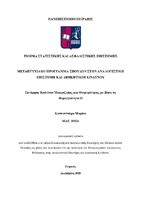Εκτίμηση κινδύνου μακροζωίας και θνησιμότητας με βάση τη Φερεγγυότητα ΙΙ
Longevity and mortality risk in Solvency ΙΙ

View/
Keywords
Longevity risk ; Mortality risk ; Solvency Capital Requirement ; SCR ; Diversification effect ; Κεφαλαιακές απαιτήσεις Φερεγγυότητας ; Κίνδυνος θνησιμότητας ; Κίνδυνος μακροζωίας ; Lee-Carter modelAbstract
The Solvency II framework, which has been implemented since 2016, refers to the insurance and reinsurance undertakings all over Europe. EIOPA has proposed the Solvency II Directive, both to harmonize European insurance regulation, as well as introduce a risk-based regulation more tailored to the risk profile of the respective insurance company. Based on this new framework, the insurance companies are obliged to change their policies and their procedures, things that have remained the same for many years. Insurers are usually considered solvent when they are able to meet their long-term financial obligations, while taking into account the risks that they are exposed to. In order to account for these risks, Solvency II requires the insurance company to hold a so-called buffer in terms of capital: the Solvency Capital Requirement (SCR). This paper is focused on the calculation of mortality and longevity risk, according to the standard formula. The SCR is calculated taking into account the result of diversification effect. This is proved to be a very useful management risk tool, as it helps the insurance companies to reduce their liabilities. Finally, additional purpose of the present paper is to compare the solvency capital requirement of the aforementioned two risks, using four different mortality tables, in order to analyze its impact as it is one of the most important assumptions, and one of them is calculated based on the use of the stochastic Lee-Carter (1992) model, using recent data, because it is proved that life expectancy has increased in recent years.


